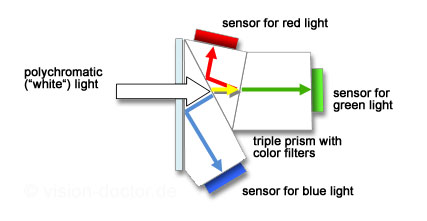Three-chip colour cameras
Simple single-chip color cameras have the disadvantage that, due to the Bayer interpolation to determine the RGB colour information from neighbouring pixels, artefacts can appear in the image and structure details become blurred. Only when using a three-chip colour camera the user is provided with the full resolution of the image.
Fields of application of three-chip colour cameras
In case of particularly realistic, colour-fast depiction of the objects and required high shade differentiation, three-chip colour cameras are used. Common fields of application are:
- Industrial precision colour measurements (detection of smallest contaminations, discolouration and colour shifts)
- Medical technology, biology, microscopy & endoscopy
- Broadcast (film & television)
Functional principle of the three-chip colour camera
The incident (white) ray of light is deflected to three sensors via a multi-piece complex prism using suitable band-elimination filters. Thus a point of light is detected on three sensors at the same time precise to the sub-pixel and generates a true RGB signal per pixel in this way.
|
It is important that the arrangement of the sensors and the prism block is extremely precise. Professional camera manufacturers accomplish the mechanic mounting and adjustment to accuracies of 0.2 pixels, i.e. within the range of µm!
Advantages and disadvantages of three-chip colour cameras
Advantages ((over single-chip colour cameras):
- Highest possible colour quality and colour fidelity: the sensors can partially be exposed and amplified varyingly long so that a perfect image is generated.
- RGB signals / pixels are represented homogeneously in contrast to single-chip colour cameras where there are twice as many green pixels. Therefore a uniform sensitivity is guaranteed. Shades of red can be differentiated very precisely, too.
- No loss of the effective resolution due to interpolation, no comb-like artefacts along the contours.
Disadvantages (compared to single-chip colour cameras):
- Rather high-priced
- Clearly limited selection of cameras and manufacturers
- Rather low resolution from VGA to 2 megapixels and smaller sensors (often 1/3") as three sensors and a complex multi-prism require more space.
- Special lenses needed
Important for machine vision
- Three-chip cameras require high-quality colour-corrected lenses which have a low immersion depth into the camera (large back focal length of the lens) in order to avoid damage to the prism block. Certain lens manufacturers offer special product lines for these cameras which are optimised for these purposes.
- Somewhat restricted temperature range compared to simple single-chip camera solutions due to the alteration of the mechanic alignment (alignment precise to the µm!) of the sensors based on thermal expansion effects.








